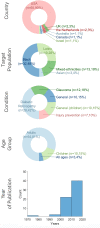Interventions to promote access to eyecare for non-dominant ethnic groups in high-income countries: a scoping review
- PMID: 34493531
- PMCID: PMC8424858
- DOI: 10.1136/bmjgh-2021-006188
Interventions to promote access to eyecare for non-dominant ethnic groups in high-income countries: a scoping review
Abstract
Purpose: People who are distinct from the dominant ethnic group within a country can experience a variety of barriers to accessing eyecare services. We conducted a scoping review to map published interventions aimed at improving access to eyecare for non-Indigenous, non-dominant ethnic groups residing in high-income countries.
Methods: We searched MEDLINE, Embase and Global Health for studies that described an intervention to promote access to eyecare for the target population. Two authors independently screened titles and abstracts followed by review of the full text of potentially relevant sources. For included studies, data extraction was carried out independently by two authors. Findings were summarised using a combination of descriptive statistics and thematic analysis.
Results: We screened 5220 titles/abstracts, of which 82 reports describing 67 studies met the inclusion criteria. Most studies were conducted in the USA (90%), attempted to improve access for Black (48%) or Latinx (28%) communities at-risk for diabetic retinopathy (42%) and glaucoma (18%). Only 30% included the target population in the design of the intervention; those that did tended to be larger, collaborative initiatives, which addressed both patient and provider components of access. Forty-eight studies (72%) evaluated whether an intervention changed an outcome measure. Among these, attendance at a follow-up eye examination after screening was the most common (n=20/48, 42%), and directly supporting patients to overcome barriers to attendance was reported as the most effective approach. Building relationships between patients and providers, running coordinated, longitudinal initiatives and supporting reduction of root causes for inequity (education and economic) were key themes highlighted for success.
Conclusion: Although research evaluating interventions for non-dominant, non-Indigenous ethnic groups exist, key gaps remain. In particular, the paucity of relevant studies outside the USA needs to be addressed, and target communities need to be involved in the design and implementation of interventions more frequently.
Keywords: eye diseases; health services research; public Health; review.
© Author(s) (or their employer(s)) 2021. Re-use permitted under CC BY. Published by BMJ.
Conflict of interest statement
Competing interests: None declared.
Figures




Similar articles
-
Beyond the black stump: rapid reviews of health research issues affecting regional, rural and remote Australia.Med J Aust. 2020 Dec;213 Suppl 11:S3-S32.e1. doi: 10.5694/mja2.50881. Med J Aust. 2020. PMID: 33314144
-
Interventions to promote access to eye care for non-Indigenous, non-dominant ethnic groups in high-income countries: a scoping review protocol.BMJ Open. 2020 Jun 3;10(6):e033775. doi: 10.1136/bmjopen-2019-033775. BMJ Open. 2020. PMID: 32499258 Free PMC article.
-
Folic acid supplementation and malaria susceptibility and severity among people taking antifolate antimalarial drugs in endemic areas.Cochrane Database Syst Rev. 2022 Feb 1;2(2022):CD014217. doi: 10.1002/14651858.CD014217. Cochrane Database Syst Rev. 2022. PMID: 36321557 Free PMC article.
-
Eye care delivery models to improve access to eye care for Indigenous peoples in high-income countries: a scoping review.BMJ Glob Health. 2021 Mar;6(3):e004484. doi: 10.1136/bmjgh-2020-004484. BMJ Glob Health. 2021. PMID: 33762252 Free PMC article.
-
Eye care delivery models to improve access to eye care for Indigenous people in high-income countries: protocol for a scoping review.BMJ Open. 2019 Jul 29;9(7):e029214. doi: 10.1136/bmjopen-2019-029214. BMJ Open. 2019. PMID: 31362967 Free PMC article.
Cited by
-
Use of public sector diabetes eye services in New Zealand 2006-2019: Analysis of national routinely collected datasets.PLoS One. 2023 May 18;18(5):e0285904. doi: 10.1371/journal.pone.0285904. eCollection 2023. PLoS One. 2023. PMID: 37200245 Free PMC article.
-
Eye health for all in Aotearoa New Zealand: Summarising our situation using a WHO tool.Lancet Reg Health West Pac. 2022 Dec 15;30:100665. doi: 10.1016/j.lanwpc.2022.100665. eCollection 2023 Jan. Lancet Reg Health West Pac. 2022. PMID: 36578503 Free PMC article. No abstract available.
-
'Whatever the GP says, is what I'll do'-A qualitative study of patient perspectives in accessing primary eye care for type 2 diabetes.Ophthalmic Physiol Opt. 2025 Jan;45(1):67-76. doi: 10.1111/opo.13398. Epub 2024 Oct 4. Ophthalmic Physiol Opt. 2025. PMID: 39365256 Free PMC article.
-
Access to Myopia Care in the United States-A Narrative Review.Invest Ophthalmol Vis Sci. 2025 Jun 5;66(7):5. doi: 10.1167/iovs.66.7.5. Invest Ophthalmol Vis Sci. 2025. PMID: 40471571 Free PMC article. Review.
-
Vision Impairment and Frailty Among Mexican American Older Adults: A Longitudinal Study.J Appl Gerontol. 2024 Jun;43(6):755-764. doi: 10.1177/07334648241231374. Epub 2024 Feb 27. J Appl Gerontol. 2024. PMID: 38412864 Free PMC article.
References
-
- Tranforming our world: the 2030 agenda for sustainable development: United Nations 2015.
-
- Indigenous peoples and ethnic minorities: marginalization is the norm. promoting inclusion through social protection United Nations 2018.
-
- Holmes L, Enwere M, Williams J. Black–White risk differentials in COVID-19 (SARS-COV2) transmission, mortality and case fatality in the United States: translational epidemiologic perspective and challenges. International Journal of Environmental Research and Public Health 2020;17:4322. - PMC - PubMed
Publication types
MeSH terms
Grants and funding
LinkOut - more resources
Full Text Sources
Miscellaneous
